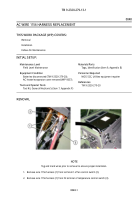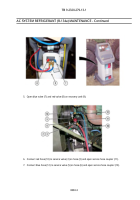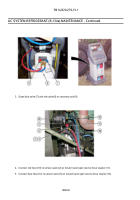TB-9-2320-279-13-1 - Page 365 of 524
TB 9-2320-279-13-1
0049-1
0049
AIR CONDITIONING LEAK TEST
DRAFT
-
-
-
-
-
-
-
-
-
-
-
-
-
-
-
-
-
-
-
-
-
-
-
-
-
-
-
-
-
-
-
-
-
-
-
-
-
INSPECTION
WARNING
•
Use care to prevent refrigerant from touching your skin or eyes. Liquid refrigerant,
when exposed to air, quickly evaporates and will freeze skin or eye tissues. Serious
injury or blindness may result if you come in contact with liquid refrigerant.
•
Refrigerant R-134a air conditioning systems should not be pressure tested or leak
tested with compressed air. Combustible mixtures of air and R-134a may form,
resulting in a fire or explosion, which could cause personnel injury or death.
NOTE
•
Refrigerant is odorless. As a result, all of it may leak away and not be noticed until system
stops cooling. All vehicle refrigerant systems lose some refrigerant depending on
condition of system. Higher loss rates signal a need to locate and repair leaks.
•
Leaks are most often found at compressor hose connections and at various fittings and
joints in system. If unapproved replacement hoses are installed, refrigerant can be lost
through hose permeation.
1. Visually inspect refrigerant system for air conditioning lubricant leakage and corrosion and damage to
lines, hoses, and other components.
2. Visually inspect lowest points of fittings, hoses, and lines for indication of lubricant leakage.
THIS WORK PACKAGE (WP) COVERS:
Inspection
Test
Follow-On Maintenance
INITIAL SETUP:
-
-
-
-
-
-
-
-
-
-
-
-
-
-
-
-
-
-
-
-
-
-
-
-
-
-
-
-
-
-
-
-
-
-
-
-
-
Maintenance Level
Field Level Maintenance
Equipment Condition
Engine cover opened and engine side panel
removed (TM 9-2320-279-10).
Tools and Special Tools
Tool Kit, General Mechanic’s (Item 7, Appendix F)
Leak Detector, Refrigerant (Item 1, Appendix H)
Materials/Parts
None
Personnel Required
MOS 52C, Utilities equipment repairer
References
TM 9-2320-279-10
Back to Top




















